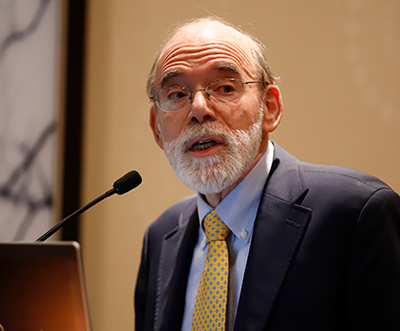Experts Discuss Steps Being Made to Ensure DSM Is Living Document

“We are moving toward the day when the canonical DSM will not be the volume sitting on your desk but will be online,” said past APA President Paul Appelbaum, M.D. (pictured above), and chair of the APA DSM Steering Committee, during a symposium held today on updating the DSM.
That day may still be in the future, but APA has initiated a process for incorporating changes to the DSM and is currently considering changes submitted by clinicians and researchers—on an incremental basis, making use of digital technology. It is intended to fulfill the vision, expressed by the Board of Trustees, to make the DSM a “living document.”
Appelbaum was joined at the symposium by Steering Committee vice chairs Kenneth Kendler, M.D., Ph.D., and Ellen Liebenluft, M.D.
Appelbaum said the new process marks a “sea change” from that which characterized changes to previous editions. For instance, the current DSM-5 is the product of a multi-year process that began in 1999 and involved more than 160 workgroups. While necessary, the process was cumbersome, time consuming, and costly; tended to incentivize proliferation of diagnostic categories; and relied too heavily on expert opinion rather than data.
Now, seizing on the opportunity afforded by digital communication, a process exists for changes to be made to DSM as warranted by the weight of new evidence via a portal on the APA website. Appelbaum said it’s a process in which APA members, other mental health clinicians, members of the research community, and members of the public can participate.
Visitors to the portal are guided through steps to submit proposals for the following specific kinds of revisions:
- Changes to an existing diagnostic criteria set that would markedly improve its validity.
- Changes to an existing diagnostic criteria set that would markedly improve reliability without an undue reduction in validity.
- Changes to an existing diagnostic criteria set that would markedly improve clinical utility without an undue reduction in validity or reliability.
- Changes to an existing diagnostic criteria set that would substantially reduce deleterious consequences associated with the criteria set without a reduction in validity.
- Addition of a new diagnostic category or specifier.
- Deletion of an existing diagnostic category or specifier/subtype.
- Corrections and clarifications, including changes aimed at improving the understanding and application of an ambiguous diagnostic criterion, specifier, or text.
Proposals require the submission of supporting information in a structured format, including the details of the proposed change, reasons for the change, the magnitude of change, data documenting improved validity across a range of validators, evidence of reliability and clinical utility, and consideration of potential deleterious consequences of associated with the proposed change. Explicit criteria for what is required when submitting changes are on the website.
The steering committee will work with five standing review committees to review proposals, consider the supporting evidence, and undertake literature reviews and expert consultations as necessary. Appelbaum said the process will be guided by two competing values: the need to keep up with research and the need to maintain stability and consistency in the text. “Change is not always a good thing,” he said. “Stability promotes consistency, in research and clinical practice.
“But sometimes change is necessary when emerging evidence justifies it,” he said.
The bar for acceptance will be relatively high. “We are looking for a substantial scholarly effort,” said Kendler. “The larger the change the more evidence you will want to provide. … We are inherently suspicious of requests for changes that rely solely on your own research.”
The committee has fielded and is reviewing proposals for new diagnostic criteria for a diagnosis currently in Section 3 of the DSM-5, additions and rearrangements to criteria for other existing disorders, and changes to the text regarding the time course of a disorder, among others. “The best proposals are coming from groups of people who pool their data and come to a consensus on the change they are advocating,” Appelbaum said.
(Image: David Hathcox)
|
|
|
|
Advertisement
 |
|
 |
|
|






